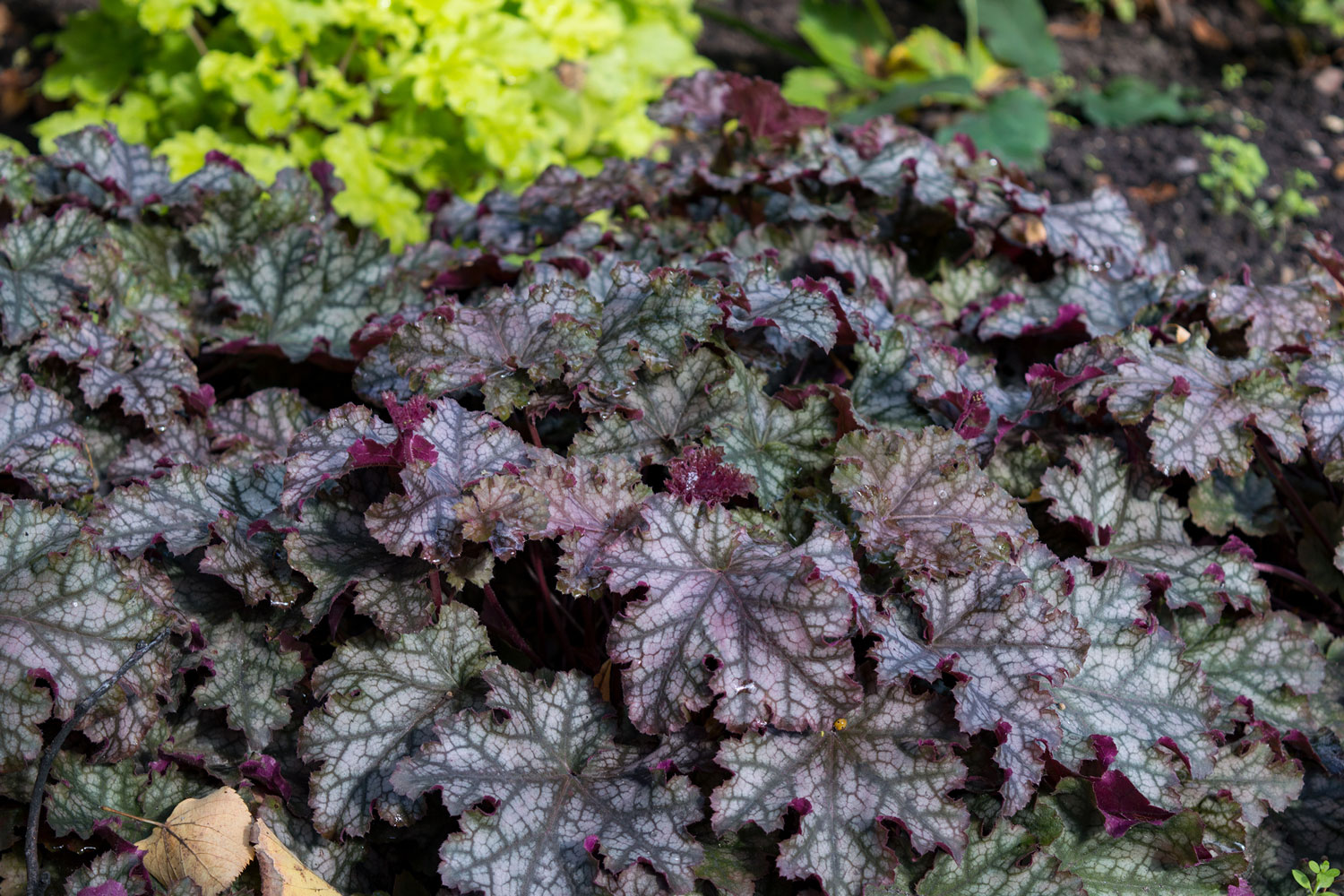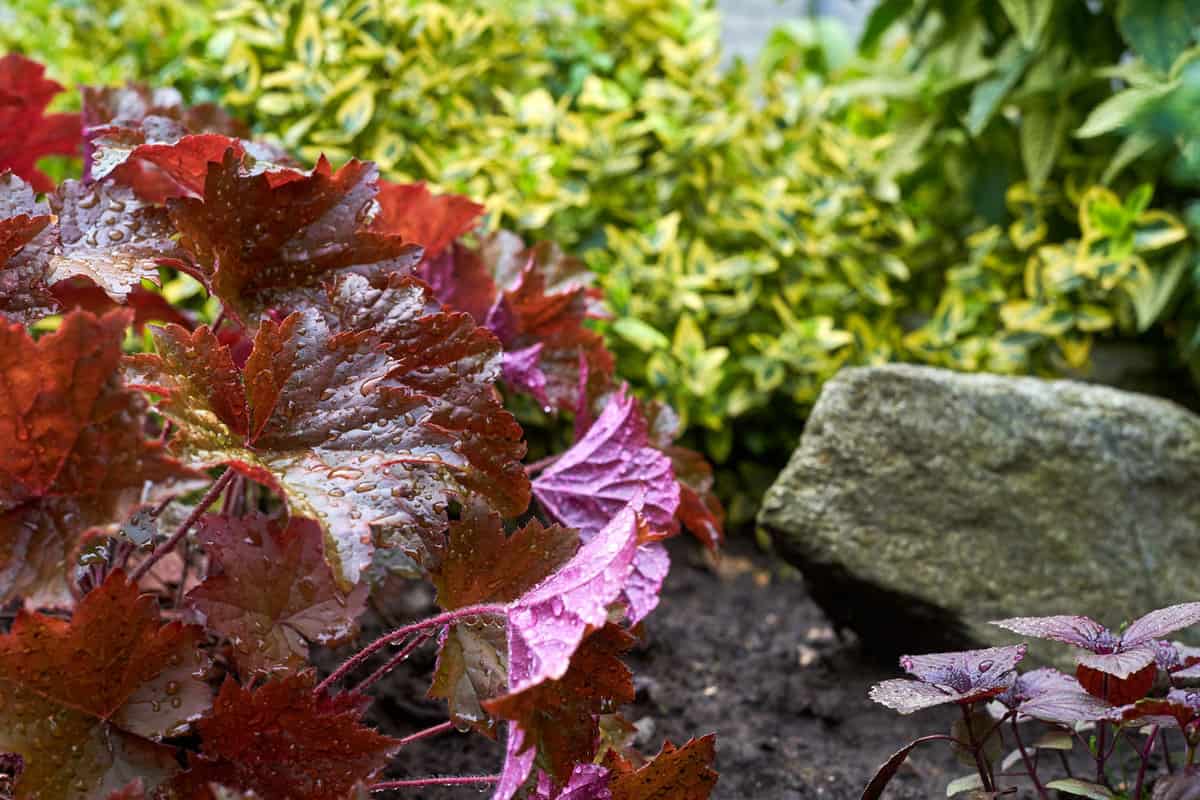Searching for the ideal centerpiece for your garden? Meet the captivating black coral bells, also known as Heuchera.
These plants are celebrated for their mesmerizing foliage and easy care, making them a favorite among seasoned and budding gardeners.
Black coral bells are available in a variety of types, each with their own unique characteristics.
Explore these remarkable varieties of Black Coral Bells and find your perfect match:
- Obsidian Black Coral Bells
- Blackout Black Coral Bells
- Midnight Rose Black Coral Bells
- Palace Purple Black Coral Bells
Keep reading to learn more about caring for these beautiful plants and see pictures of different types!
A Garden's Dark Jewel
Black Coral Bells belong to the genus Heuchera, which falls under the family Saxifragaceae.
This genus comprises numerous perennial species native to North America, widely recognized for their attractive foliage and delicate, bell-shaped flowers. The term "Black Coral Bells" commonly refers to specific cultivars of Heuchera with dark, near-black foliage.
With their versatility and visual appeal, Black Coral Bells is a splendid choice, whether you're looking to enhance your garden or bring a piece of nature indoors.
Types of Black Coral Bells
Obsidian Black Coral Bells
Obsidian Black Coral Bells are a stunning variety with glossy, deep black leaves. This plant is an excellent option for those looking to add a touch of drama to their garden, and it pairs well with bright flowers and foliage.

Obsidian Black Coral Bells can grow up to 24 inches in height, and they prefer partial shade to full sun.
Blackout Black Coral Bells
Blackout Black Coral Bells are another popular variety with dark, almost black leaves. This plant is smaller than Obsidian, growing up to 9 inches tall and 12 inches wide.

Blackout Black Coral Bells prefer partial shade to full sun and are known for their tolerance to drought.
Midnight Rose Black Coral Bells
Midnight Rose Black Coral Bells are a unique variety that features dark leaves with bright pink speckles.

This plant is a great option for those looking to add a pop of color to their garden, and it pairs well with other pink or purple flowers.
Midnight Rose Black Coral Bells can grow up to 24 inches tall and 12 inches wide, and they prefer partial shade to full sun.
Palace Purple Black Coral Bells
Palace Purple Black Coral Bells are a classic variety that features deep purple leaves. This plant is a great option for those looking for a more subtle addition to their garden, and it pairs well with almost any other plant or flower.

Palace Purple Black Coral Bells can grow up to 18 inches tall and 24 inches wide, and they prefer partial shade to full sun.
Black Coral Bells Care Tips
If you've decided to add Black Coral Bells to your garden, congratulations! These plants are a great choice for adding color and texture to any landscape.
However, to keep your Black Coral Bells looking their best, there are a few things you need to keep in mind. Here are some care tips to help you grow healthy and vibrant Black Coral Bells.
Light Requirements
Black Coral Bells prefer partial shade, especially in hotter climates. Too much sun can cause the leaves to scorch and the color to fade.
In areas with cooler temperatures, they can tolerate more sun. If you're planting in an area with full sun, make sure to provide some afternoon shade to protect the leaves from the hot afternoon sun.
Watering Tips
Like most plants, Black Coral Bells prefer moist, well-drained soil. Keep the soil evenly moist, but not waterlogged. Overwatering can lead to root rot, which can kill the plant.
Water deeply once or twice a week, depending on the weather and soil conditions. During periods of drought, make sure to water more frequently.
Soil and Fertilizer Preferences
Black Coral Bells prefer soil that is rich in organic matter and well-draining. They do best in soil with a pH between 6.0 and 7.0.
To improve soil quality, amend the soil with compost or well-rotted manure before planting. Fertilize once a month during the growing season with a balanced fertilizer. Avoid over-fertilizing, as this can lead to weak growth and poor coloration.
Pruning and Maintenance
Black Coral Bells require minimal pruning. Remove any dead or damaged leaves as needed to keep the plant looking neat and tidy.
In the fall, cut the plant back to about 3 inches above the ground. This will help promote new growth in the spring. Black Coral Bells are generally pest and disease-free, but keep an eye out for slugs and snails, which can damage the leaves.
Common Problems and Solutions
Black Coral Bells are generally easy to care for, but they can still experience some issues. Here are some common problems that you may encounter while growing Black Coral Bells and how to solve them.
Pests and Diseases
Black Coral Bells are susceptible to pests and diseases, just like any other plant. Some of the common pests that may attack your Black Coral Bells are aphids, spider mites, and slugs. These pests can cause damage to the leaves and flowers of your plant.
To get rid of these pests, you can use insecticidal soap or neem oil. These are natural remedies that are safe for your plant and the environment.
You can also try using companion planting to keep pests away. For example, planting garlic or chives near your Black Coral Bells can help repel aphids.
Black Coral Bells can also develop diseases such as rust, powdery mildew, and leaf spot. These diseases can cause discoloration and damage to the leaves.
To prevent these diseases, make sure your plant has good air circulation and is not overcrowded. Also, avoid getting water on the leaves when watering your plant.
Overwatering
Overwatering is one of the most common problems that Black Coral Bells face. When the soil is too wet, the roots of the plant can rot, which can eventually lead to the death of the plant.
To avoid overwatering your Black Coral Bells, make sure the soil is well-draining and that the pot has drainage holes.
You can also check the moisture level of the soil by sticking your finger about an inch into the soil. If the soil feels dry, it's time to water. If it feels moist, wait a few more days before watering.
Sunburn
Black Coral Bells prefer partial shade to full shade. But if they are exposed to too much sun, the leaves can become scorched and turn brown.
To avoid sunburn, make sure your plant is in a shaded area. You can also use shade cloth or a sheer curtain to filter the sunlight.
Click here to buy this neem oil on Amazon.
Click here to buy this sunblock shade cloth on Amazon.
Interesting Facts About Black Coral Bells
Black Coral Bells, also known as Heuchera 'Obsidian,' are a widespread variety of coral bells prized for their striking foliage. Here are some interesting facts about this unique plant:
- These coral bells is perfect for borders, rock gardens, and containers.
- Black Coral Bells are known for attracting hummingbirds and butterflies to your garden. This makes them an excellent choice for gardeners who want to create a wildlife-friendly space.
- You can propagate Black Coral Bells by dividing the plant in the spring or fall. Simply dig up the plant, divide it into smaller sections, and replant them in well-draining soil.
Rest assured, nurturing these plants to their full potential is within your reach, making them an exquisite yet manageable centerpiece for your space.
You might want to check these related posts:


